- News
- Reviews
- Bikes
- Accessories
- Accessories - misc
- Computer mounts
- Bags
- Bar ends
- Bike bags & cases
- Bottle cages
- Bottles
- Cameras
- Car racks
- Child seats
- Computers
- Glasses
- GPS units
- Helmets
- Lights - front
- Lights - rear
- Lights - sets
- Locks
- Mirrors
- Mudguards
- Racks
- Pumps & CO2 inflators
- Puncture kits
- Reflectives
- Smart watches
- Stands and racks
- Trailers
- Clothing
- Components
- Bar tape & grips
- Bottom brackets
- Brake & gear cables
- Brake & STI levers
- Brake pads & spares
- Brakes
- Cassettes & freewheels
- Chains
- Chainsets & chainrings
- Derailleurs - front
- Derailleurs - rear
- Forks
- Gear levers & shifters
- Groupsets
- Handlebars & extensions
- Headsets
- Hubs
- Inner tubes
- Pedals
- Quick releases & skewers
- Saddles
- Seatposts
- Stems
- Wheels
- Tyres
- Health, fitness and nutrition
- Tools and workshop
- Miscellaneous
- Tubeless valves
- Buyers Guides
- Features
- Forum
- Recommends
- Podcast
review
£479.00
VERDICT:
Draggy coaster brake takes the shine off this affordable singlespeed folder but or shorter, flatter journeys, it's fine
Weight:
11,870g
Contact:
At road.cc every product is thoroughly tested for as long as it takes to get a proper insight into how well it works. Our reviewers are experienced cyclists that we trust to be objective. While we strive to ensure that opinions expressed are backed up by facts, reviews are by their nature an informed opinion, not a definitive verdict. We don't intentionally try to break anything (except locks) but we do try to look for weak points in any design. The overall score is not just an average of the other scores: it reflects both a product's function and value – with value determined by how a product compares with items of similar spec, quality, and price.
What the road.cc scores meanGood scores are more common than bad, because fortunately good products are more common than bad.
- Exceptional
- Excellent
- Very Good
- Good
- Quite good
- Average
- Not so good
- Poor
- Bad
- Appalling
The Uno is one of the cheapest models in Tern's 20-inch wheel Link range. It costs about half as much as the benchmark commuting folder, the Brompton. As you'd expect from the Uno's name, there's a single gear. There's just one brake lever too, as the rear is a cable-free coaster. That avoids the clutter of convoluted cables but introduces some resistance in the rear hub, which is most noticeable at slow pedalling speeds – climbing hills, for example.
If you're buying a singlespeed, you're probably not intending to head for the hills. But even in flat city like London you'll run into them from time to time, so you need to weigh up the advantages of simplicity and less weight against the disadvantage of having to grind up any climbs you do encounter.
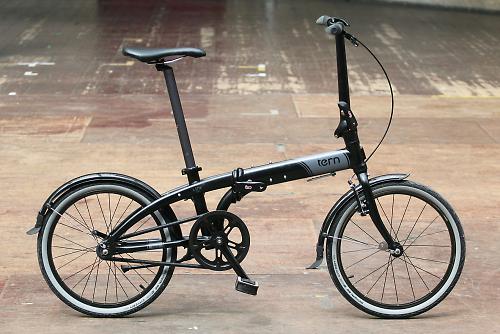
There are geared alternatives. While Tern seem to have dropped the two-speed Duo, you can get a 7-speed Nexus hub gear version for £649, a 7-speed derailleur model for £429, and an 8-speed derailleur one for £519. Tern's US website lists 16- and 24-speed versions too, but UK distributor Paligap's doesn't. I don't think that's any great loss. This design feels like a commuter folder to me, however you dress it up.
Frame and fork
With a big hinge in the main frame tube to fold the bike in half, the Tern Uno looks similar to a Dahon. That's not surprising. Tern was set up by the son of Dahon's founder, David Hon, and his wife. They both used to work for Dahon. There was litigation. It's been resolved now but you can still see some features common to both bikes – the Magnetix frame clips, for example.

The main frame hinge folds in a different way, however. Tern call it an N-fold. The front wheel stays pointing forward as the frame folds back. That reduces the length of the folded package a little, since the fork legs curve forward.
Any hinge gives the opportunity for flex. The Uno frame hinge is robustly designed to limit this. There's a lot of metal at this point and the frame is triangulated both vertically, thanks to the little 'down tube' to the bottom bracket, and laterally: the seat-stays extend past the seat tube to meet at the hinge. Tern call this 'Double Truss Technology'.
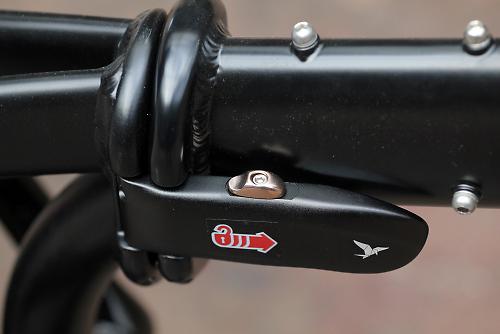
The aluminium frame has fittings for a rear rack and a mudguard. There aren't any V-brake bosses on the seat-stays, which is tidier but limits your options if you decide you don't like the coaster brake. A long-reach sidepull brake should work – and by long reach, I mean 75mm rather than 57mm. Alternatively, you could go fixed wheel. The dropouts are rear facing already, so that you can tension the singlespeed chain, and they're 120mm wide.
The head tube has a Luggage Socket: a mounting point for a front bag, similar to (and surely inspired by) the Brompton. It's a good place to fit luggage to a small-wheeled folder. Limited heel clearance and the proximity of the tarmac means that it can be impractical to carry panniers on a small-wheeler's rear rack. And having more weight over the front wheel helps counteract a small-wheeler's quicker steering.

There are three sets of bottle bosses on the main frame tube, one on the top and one set each side. Leaving bottle cages attached to the side would compromise the fold, so in the unlikely event that you need to carry three bottles you'd be better off using Monkii cages instead (/content/news/76245-just-monkii-attachment-system-video).
The steel fork has mudguard eyelets and, unusually, rear facing V-brake bosses. Because of the N-fold, this means the forward-facing front wheel looks a bit like it's pointing to the rear. As a result, I made a hash of unfolding the bike a few times and ended up with the front wheel either pointing backwards or rotated through 360 degrees, with the brake cable wrapped around the stem.

Components
Despite its location the anonymous front V-brake works fine. Initially, at least. The behind-the-fork position means that the brake pads are skewed relative to the brake arms, and the small wheel diameter exacerbates this angle. I'd want a parallel push V-brake here to ensure even pad wear and consistently good braking performance.
I'd switch the single brake lever to the lefthand side. I run my fixed-wheel bikes like that to make it easier to stay in control while signalling righthand turns. It would also make the cable run shorter and neater.

The rear coaster brake offers weatherproof braking that's not just neat but cable-free. If you're not used to pedalling backwards to brake, go easy at first; it's not difficult to skid. Skidding is especially easy if you stand up on the pedals to freewheel over a bit of bumpy road. If your feet rock backward, you'll apply the coaster brake just when you've got less traction on the lighter-loaded rear wheel. I learned my lesson quickly after nearly falling off, and took care to stay seated on descents after that.
To apply the brake effectively, you need the cranks roughly level. I didn't find this a problem. What is awkward is starting off again after you've stopped. You can't pedal backwards to put the cranks in the optimum position. Without clipless pedals, I wasn't able to use the fixed-wheel trick of applying the front brake and pushing the bike forward so the rear wheel lifts, then spinning the cranks into position. For a bike that will be used for stop-start urban journeys, this is a big deal. I often ended up pushing off from the floor with one foot and jumping on the saddle cyclo-cross style to get moving. It wasn't elegant and it wasn't quick.

There's another issue with this coaster brake hub: it drags. At first I thought the cones had been done up too tightly. But no: I adjusted them and it still felt treacly. With the bike on a workstand, the rear wheel will spin tolerably well. It's not especially noticeable when you're spinning easily along on the flat either. You feel the drag when you're pedalling uphill slowly and with a lot of torque. Then it feels like you're riding with the brake partly on, which I guess you are.
I suppose I could have taken the hub apart (or tried to) and greased everything, but the attraction of a coaster brake should be less maintenance, not more. And while I might have reduced the drag, I'm not sure I could have eliminated it. Any coaster brake has the brake shoes very close to the braking surface, with only the clutch mechanism keeping them apart. Every coaster brake hub I've used - singlespeed, two speed and three speed - has had some additional drag, relative to hubs with only ball bearings between the rapidly rotating hub shell and the stationary axle. The Link's hub is no worse than others I've used, and it's better than some.

The singlespeed gear is 68 inches. That's about right for the flat streets it's meant for, although I'd go lower because I prefer to pedal faster. The chain is a 3/32in one. You can't see it because it's hidden by the Biologic FreeDrive chain guard. This a plastic tube in a C-section that encloses all but the inner side of the chain. It buzzes a bit as you pedal but doesn't offer much friction. It's meant to keep oil of your trousers, I guess, but it doesn't protect the chain or your clothing like a proper chain guard. I would pull it off and throw it in the bin. Cycle clips are easy to carry, don't complicate your chain cleaning/lubing routine, and can't conceivably come loose and get wrapped around moving bits of your bike.
The Schwalbe Citizen tyres resist punctures pretty well. They're 42mm wide, so you'd have to be unlucky or very heavy to suffer a pinch puncture, and there's a puncture resistant layer under the tread. But they're a bit stodgy; I'd upgrade them for suppler, faster tyres, such as Schwalbe Kojaks. With better quality tyres, small wheels can roll as well as large ones.
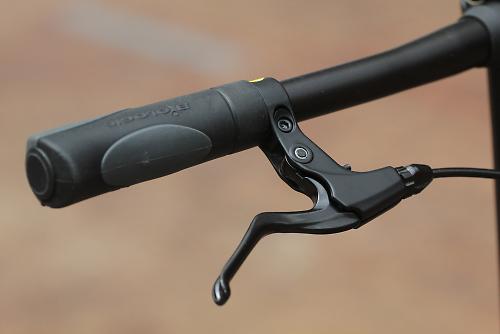
Contact points are fine. The flared, Ergon-style grips are comfortable. The folding pedals work well enough, won't scuff street shoes, and come with integral reflectors. I didn't really notice the saddle at all.
It's frustrating that the long seatpost doesn't have height markers on it. I often put the saddle at slightly the wrong height when unfolding the bike, and then had to stop down the road to re-set it.
It's nice to see mudguards fitted as standard. On a bike like this, you'll be cycling in normal clothes, and you don't want those clothes to be sprayed with dirty water. The stays will pop free at the mudguard end if anything gets jammed under them.
The fold
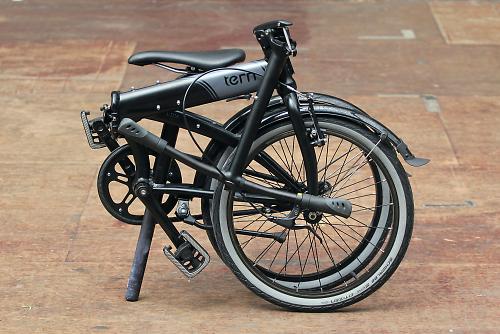
Folding the Tern Uno is straightfoward; it's not the collapsible magic trick of a Brompton or Birdy. First you deploy the kickstand, which enables the bike to stand up both now and when it's folded. Then lower the saddle all the way down. (Shorter riders might be able to lower the saddle later, but I found it hit the handlebar unless I did it at this point.) Then undo the main hinge and 'N-fold' the front end back, so that the Magnetix clips on the righthand fork leg and lefthand chain-stay butt together. Undo the stem hinge and drop the handlebar down against the front wheel. There's a rubber strap under the main frame tube to secure the stem – simple but effective. Fold the pedals and you're done.

The resulting package measures 79x70x36cm. That's a lot bigger than a Brompton but it's still small enough for train's luggage rack. It's lighter than it looks and no more difficult than an entry-level Birdy or Brompton to carry. I carried it by the saddle. When I carried it by the main frame tube, it tended to flop open around the main hinge. The magnets holding it together aren't that strong.
If you don't like the idea of carrying the Uno, for £40 more you can get the model with a Trolley Rack. This is a rear rack with castor wheels on it, so you can tow the folded Uno rather than carrying it. This rack includes a cover, so the bike looks more like luggage.

Tern reckon that you can fold the Uno in 10 seconds. It took me about twice that, and somewhat longer to unfold it, largely because of the time it took to get the saddle to the right height.
The hinges are well designed. There are safety catches you have to slide open before you can undo the clasps, so they won't open accidentally. And when you unfold the Uno, the clasps self-lock as you close them. Curiously, there's a quick-release clamp – without a safety catch – for the handlebar. Presumably this is so that you can rotate the flat handlebar to make the folded bike a tiny bit narrower. I couldn't think of any circumstances in which I'd need to do that, so would rather have an allen-bolted clamp instead.
The ride
Twenty-inch wheels increase the size of the folded bike but improve the ride. Bumps and potholes aren't the alarming issue that they are on 16in wheels. The medium-fat tyres help.
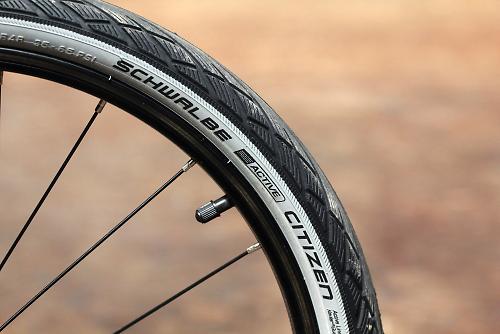
Like a lot of folding bikes, the Uno doesn't have a huge amount of trail, so steering is fairly quick. It doesn't feel skittish, however. The wheelbase is as long as a conventional, big-wheeled bike's. Those 42mm tyres add a bit of steering inertia. There's no noticeable flex in either the frame or the stem, so there's none of that wet-spaghetti unpredictability that folding bikes sometimes display.
You can't change the handlebar height or reach. I didn't need to, but then I'm an average height bloke. It meant I was sitting fairly upright, like on most folders, but that's fine for rides of a handful of miles. Tall riders might find it a bit cramped. (Recommended height range is 4ft 8in to 6ft 3in.)

The only real downside is the drag from the rear hub. Like tinnitus, it's always there in the background. On the flat, you can tune it out; casual cyclists might not even notice it, just as they might not notice under-inflated tyres. As soon as the road kicks up, it intruded on my ride. Whether it was a long, gradual slope or a steep short one, it was frustratingly hard work. You know what it's like riding uphill on a hub-geared bike with a treacly bottom gear? Like that. I'd fit a fixed-hub rear wheel and clipless pedals. It'd be just as simple, even lighter, and more efficient.
Verdict
Draggy coaster brake takes the shine off this affordable singlespeed folder but or shorter, flatter journeys, it's fine
road.cc test report
Make and model: Tern Link Uno (D1) MO
Size tested: n/a
Tell us what the product is for, and who it's aimed at. What do the manufacturers say about it? How does that compare to your own feelings about it?
Tern say: THE SIMPLE ONE
Getting from point A to point B doesn't have to be a complicated thing, and neither does your transportation. If you live in a flat city, you only need one good gear for going fast. Unfold, ride, arrive. Repeat as needed.
I'd say: It's a simple, budget folding bike for short distance urban rides. Preferably flat.
Tell us some more about the technical aspects of the product?
Price: £479
Sizes: one size
Weight: 11.87kg
Frame & Fork: 6061 aluminium frame with rear-facing dropouts, 'OCL Joint' and 'DoubleTruss' design, and fittings for mudguards, rear rack, Tern front bag, one bottle cage, and coaster brake. Hi-ten steel fork with mudguard fittings.
Wheels: 42-406 Schwalbe Citizen tyres, 406-19 aluminium rims with wear line (and scrader valve holes), 20x2 2.0mm stainless steel spokes in front wheel, 28x2 2.0mm spokes in rear wheel, Formula Mini front hub, unbranded coaster hub (120mm OLN).
Transmission: Suntour folding pedals, 170mm aluminium chainset with 48T chainring, 3/32in chain, 14T sprocket. 68in gear.
Braking: unbranded front V-brake, unbranded coaster brake
Steering & Seating: Biologic Ergo grips, 580x25.4mm aluminium handlebar, Tern folding stem with QR clamps, Flux headset. Sport saddle, 33.8mm single-bolt seatpost.
Accessories: chromplastic mudguards, BioLogic FreeDrive chainguard, kickstand, Magnetix 2.0 clips
Folded size: 36x79x70 cm
Contact: paligap.cc
DIMENSIONS
Seat clamp centre to stem clamp centre (horizontal) 630
Effective top tube 580
Standover 550
Seat angle 76.5
Head angle 72.5
Fork offset 35
Trail 40
Overall wheel diameter (inc tyre) 488
Crank length 170
Seat tube length (centre to top) 260
BB to ground 285
Chainstay length 390
BB to front hub 610
Wheelbase 1010
Rear wheel hub spacing 120
Tyre width 42
ISO wheelsize at bead seat 406
Rate the product for quality of construction:
8/10
Strongly built.
Rate the product for performance:
5/10
Good, apart from the rear hub.
Rate the product for durability:
8/10
Sturdily made.
Rate the product for weight, if applicable:
7/10
Good weight for a sub-£500 folder
Rate the product for comfort, if applicable:
6/10
Good contact points. Uncomfortable uphill.
Rate the product for value:
7/10
Tell us how the product performed overall when used for its designed purpose
If you do indeed live in a flat city, this will get you around it. So on that basis, it does what it sets out to do.
Tell us what you particularly liked about the product
Simple. Relatively light. Not expensive. Decent handling for a folder.
Tell us what you particularly disliked about the product
The draggy coaster brake hub.
Did you enjoy using the product? It was okay.
Would you consider buying the product? No. I don't live in a flat city.
Would you recommend the product to a friend? I'd recommend a geared version instead. Tern do several geared Link models.
Anything further to say about the product in conclusion?
Nice bike that would be nicer with a freer running rear hub
About the tester
Age: 45 Height: 1.78m Weight: 67kg
I usually ride: Ridgeback Solo World fixed wheel My best bike is: Planet X Pro Carbon Track. Or Whyte M109
I've been riding for: Over 20 years I ride: Every day I would class myself as: Expert
I regularly do the following types of riding: time trialling, cyclo cross, commuting, touring, club rides, sportives, general fitness riding, fixed/singlespeed, mtb,
Latest Comments
- panda 21 sec ago
I'd just buy a different fruit, unless I was such a banana fan that I'd cut expenditure elsewhere to still be able to buy them. Eventually the...
- theJewishcyclist 2 min 25 sec ago
The primary use for such high accuracy (if precise) would mainly be for a Chung method based cda measurement system, where if you want a very...
- mitsky 5 min 49 sec ago
Maybe I am misunderstanding this but... ...
- Wardy74 12 min 33 sec ago
I thought road tax pays for this stuff, silly me.
- jaymack 23 min 23 sec ago
And whomsoever gets your custom please report back. After all those that provide a good service deserve the good publicity.
- quiff 26 min 50 sec ago
Because when it was reviewed and called pricey, it was £90 for a windblock type garment. The other ones that are £100+ tend to have insulation for...
- David9694 1 hour 1 min ago
"could impact emergency services, put people off attending appointments" really surprised by this GP - so many of his patients / future patients...
- chrisonabike 1 hour 6 min ago
I red it but the grey cells didn't register - the wit was sat in my in-drey...
- Steve K 1 hour 29 min ago
A rise in Halfords bike sales suggests to me more people getting into cycling, because anyone who already cycles would be buying a bike from...
- Hirsute 1 hour 39 min ago
I still can't understand why anyone would even contemplate that, let alone actually do it.


































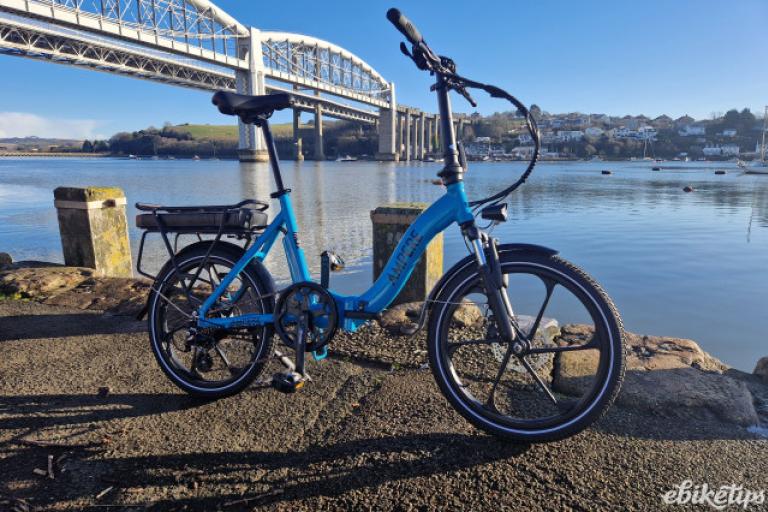
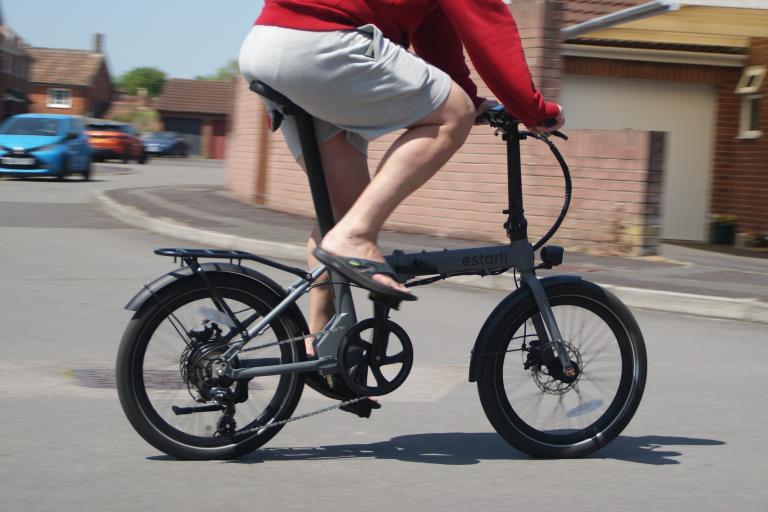
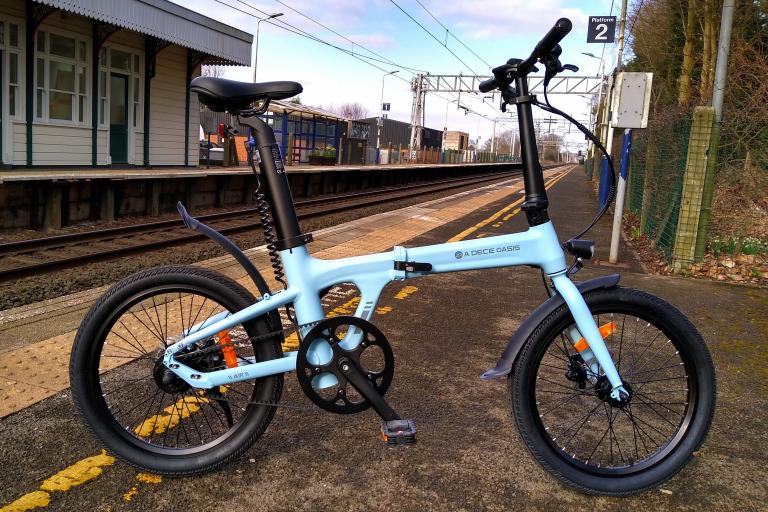
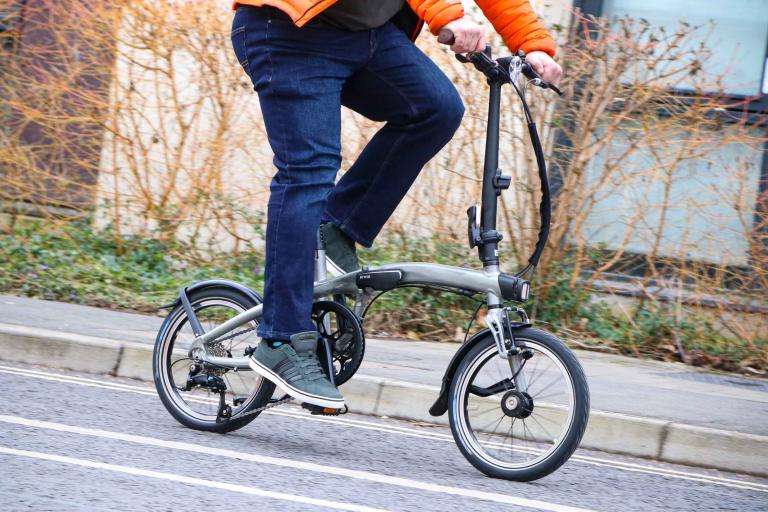
Add new comment
5 comments
I've had this bike for a month and a half, and am having a real problem with the drag on the rear brake. It's horribly inconsistent, and makes cycling uphill painfully hard at times - as you say, it feels like trying to cycle with the brake on. Have you come across any sensible solution for this sort of issue?
This is a good, honest review. I got one of these only this week, and admittedly I paid a lot less than the £479 quoted at the top. Currently on evans website its only £330! I think when you take that into consideration I'd probably bump it up and extra star. I agree with Dan about the coaster brake and moving the front brake to the left hand side [which is something I might try.] But for what I need [riding to work on pan flat roads] it's spot on. And I got it in Grey with Neon Pink... Which I rate much more than the dull black.
It's not as low as it looks. It's probably an optical illusion caused by the long stem, long seat post and small wheels. The bottom bracket is 285mm high. That's fine.
Wouldn't making a bike so low to the ground fixed be a bit problematic (pedal strike &c)?
Great review, very thorough and well-informed! You could speed up resetting the saddle height if you were to bolt a seatpost collar or something to the underneath bit of the seatpost, to act as a physical stop. Good in the dark then too!